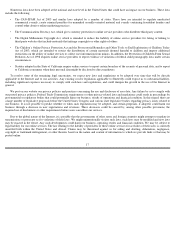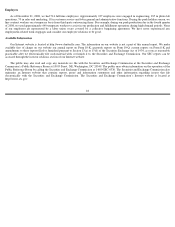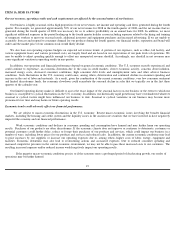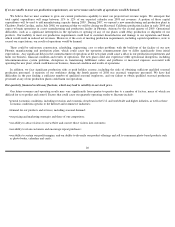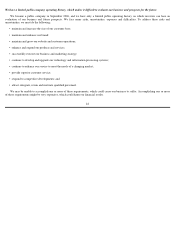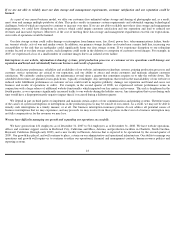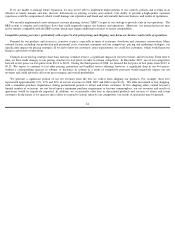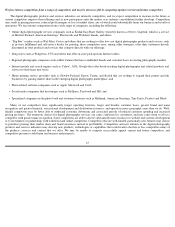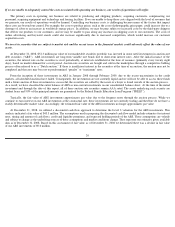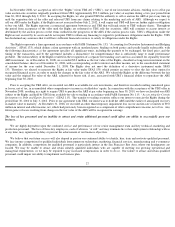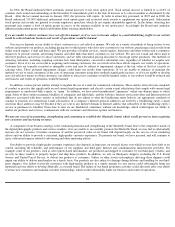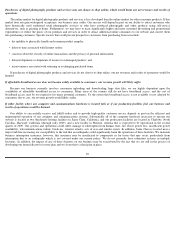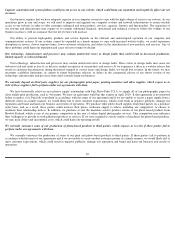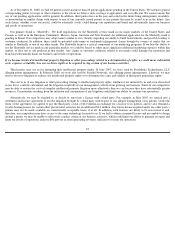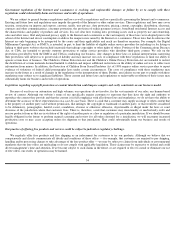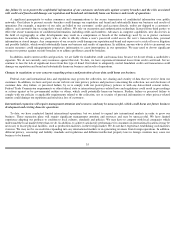Shutterfly 2009 Annual Report Download - page 28
Download and view the complete annual report
Please find page 28 of the 2009 Shutterfly annual report below. You can navigate through the pages in the report by either clicking on the pages listed below, or by using the keyword search tool below to find specific information within the annual report.
If we are unable to adequately control the costs associated with operating our business, our results of operations will suffer.
The primary costs in operating our business are related to producing and shipping products, acquiring customers, compensating our
personnel, acquiring equipment and technology and leasing facilities. If we are unable to keep these costs aligned with the level of revenues that
we generate, our results of operations would be harmed. Controlling our business costs is challenging because many of the factors that impact
these costs are beyond our control. For example, the costs to produce prints, such as the costs of photographic print paper, could increase due to a
shortage of silver or an increase in worldwide energy prices. In addition, we may become subject to increased costs by the third-
party shippers
that deliver our products to our customers, and we may be unable to pass along any increases in shipping costs to our customers. The costs of
online advertising and keyword search could also increase significantly due to increased competition, which would increase our customer
acquisition costs.
We invest in securities that are subject to market risk and the recent issues in the financial markets could adversely affect the value of our
assets.
At December 31, 2008, $52.3 million par value of our marketable securities portfolio was invested in AAA rated investments in auction-
rate
debt securities ("ARS"). ARS investments are long-term variable rate bonds tied to short-
term interest rates. After the initial issuance of the
securities, the interest rate on the securities is reset periodically, at intervals established at the time of issuance (primarily every twenty eight
days), based on market demand for a reset period. Auction rate securities are bought and sold in the marketplace through a competitive bidding
process often referred to as a “Dutch auction.”
If there is insufficient interest in the securities at the time of an auction, the auction may not be
completed and the rates may be reset to predetermined “penalty” or “maximum” rates.
From the inception of these investments in ARS in January 2008 through February 2009, due to the recent uncertainties in the credit
markets, all scheduled auctions have failed. Consequently, the investments are not currently liquid and we will not be able to access these funds
until a future auction of these investments is successful, the securities are called by the issuer or a buyer is found outside of the auction process.
As a result, we have classified the entire balance of ARS as non-
current investments on our consolidated balance sheet. At the time of the initial
investment and through the date of this report, all of these auction rate securities remain AAA rated. The assets underlying each security are
student loans and 90% of the principal amounts are guaranteed by the Federal Family Education Loan Program (“FFELP”).
Typically, the fair value of ARS investments approximates par value due to the frequent resets through the auction process. While we
continue to earn interest on our ARS investments at the contractual rate, these investments are not currently trading and therefore do not have a
readily determinable market value. Accordingly, the estimated fair value of the ARS investments no longer approximates par value.
At December 31, 2008, we utilized a discounted cash flow approach to determine the Level 3 valuation for the ARS investments. This
analysis indicated a fair value of $43.3 million. The assumptions used in preparing the discounted cash flow model include estimates for interest
rates, timing and amount of cash flows, credit and liquidity premiums, and expected holding periods of the ARS. These assumptions are volatile
and subject to change as the underlying sources of these assumptions and market conditions change. They represent our estimates given available
data as of December 31, 2008. Based on this assessment of fair value, as of December 31, 2008 we determined there was a decline in fair value
of our ARS investments of $9.0 million.
26



